Tech Blog: New Drug Treatment for Ewing’s Sarcoma

| Watch the new episode of TLA's video Tech Blog, where Jacob Schwartz provides a closer look at this novel cancer treatment.
|
Funded by the American Cancer Society and the National Cancer Institute at the National Institute of Health, Jacob Schwartz, Ph.D., professor at Department of Chemistry and Biochemistry at the University of Arizona College of Science, has created a new drug treatment for a class of cancers. Schwartz’s primary focus is Ewing’s sarcoma, a childhood cancer that is driven by the proteins he and is students are investigating.
We had the opportunity to get an inside look at Dr. Schwartz’s lab, where he discussed his invention with us, including the ultimate goal of increasing survivability for those suffering from the disease.
TLA: Tell us about the background of your invention.
Schwartz: A particular pediatric bone cancer, Ewing sarcoma, has roughly a three out of four survival rate and has seen no improvement in more than 30 years. My lab has been studying the proteins that drive not only Ewing sarcoma, but several other types ofsarcomas or cancers of the soft tissues. We have noted how the state-of-the-art therapies for treating these types of cancers hit one of the major functions of these proteins by damaging DNA with either chemotherapies or radiation. However, the second function of these proteins was left alone. We reasoned that targeting both pathways, DNA damage repair and gene transcription, in a combination would have a considerably greater effect in killing these cancers than others and, most importantly, than non-cancer cells.
TLA: What problem does it solve?
Schwartz: Two things hinder cancer treatment: (1) the efficiency with which the drug kills the cancer and (2) the selectivity in which the treatment targets a unique vulnerability found in the cancer. Getting good results on both fronts means you can get all the cancer without harming or making the patient sick. Weak results in either and you can only knock back the cancer so much before you risk too much harm to the patient. Our results indicate we are hitting both of those factors simultaneously with a treatment the cancer is far more susceptible to, and we can expect to be able to drop the dose applied to patients and reduce risk of sickening the patient. Even achieving the same result with less drug means patients, in this case most often is kids, will be able to tolerate the treatment. We’re optimistic that we can do better than current treatment options.
TLA: Who would be the top beneficiaries of a technology like this?
Schwartz: There’s an obvious biomarker coupled to our approach, which is a genetic marker that is easy to identify. Half of all mutations in sarcomas that result in splitting and splicing together chromosomes, referred to as fusions, involve one of the proteins we study and are targeting with this treatment. Ewing sarcoma is the second most common pediatric bone cancer and all of it is caused by these proteins that treatment targets. This translates to about 200 patients a year in the U.S. for that cancer alone and there is potential to bring new treatments for a much broader range of cancers.
TLA: What are you most excited about going forward?
Schwartz: What excites me is that we could combine drugs that have already seen clinical trials. This provided us special insight from the start about the potential for this treatment to work in human patients. Moreover, the concept has been considered but has not worked out for cancers that do not have the genetic markers we are targeting. The benefit here is that pharmaceutical companies have already invested time to prove that there can be even better second and third generation drugs that might exceed the positive results we’re seeing now. I think we’re just at the beginning for a road to see an improvement now and even more improvement afterward.
Interested in learning more about this invention? Would you like to talk to us about licensing opportunities? Visit the link below for details and contact information.
Also, check out these oncology-related technologies:
UA15-085: Glycoconjugates of Antiproliferative Iron Pro-Chelators Targeting Cancer Cell Metabolism
UA19-104: Novel 5-Fluorouracil Prodrug For Colorectal Cancer Therapy

